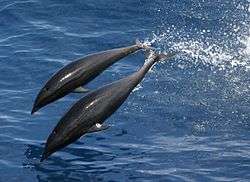Northern right whale dolphin
| Northern right whale dolphin | |
|---|---|
 | |
 | |
| Size compared to an average human | |
| Scientific classification | |
| Kingdom: | Animalia |
| Phylum: | Chordata |
| Class: | Mammalia |
| Order: | Artiodactyla |
| Infraorder: | Cetacea |
| Family: | Delphinidae |
| Genus: | Lissodelphis |
| Species: | L. borealis |
| Binomial name | |
| Lissodelphis borealis Peale, 1848[2] | |
| | |
| Range map | |
The northern right whale dolphin (Lissodelphis borealis) is a small and slender species of marine mammal found in the North Pacific Ocean. It travels in groups of up to 2000, often with other cetaceans, in deep waters of the North Pacific. The dolphin is one of two species of right whale dolphin, the other being found in cooler oceans of the Southern Hemisphere.
Classification
The species was first described by Titian Peale in 1848. The genus Lissodelphis is placed within the Delphinidae, the oceanic dolphin family of cetaceans.[2] The epithet of the genus was derived from Greek lisso, smooth, and delphis;[3] the specific epithet, borealis, indicates the northern distribution. The common names for the species formerly included northern right whale porpoise, snake porpoise, and Pacific right whale porpoise.[4][5] Both species in the genus are also referred to by the name right whale dolphin, a name derived from the right whales Eubalaena, which also lack a dorsal fin.[3][6]
Characteristics
This dolphin has a streamlined body with a sloping forehead, being more slender than other delphinids, and lacks any fin or ridge on the smoothly curving back.[7][8] The beak is short and well defined, a straight mouthline, and an irregular white patch on chin. The flippers are small, curved, narrow and pointed, the body is mostly black while the underside is partly white or lighter in colour. The tail flukes are triangular and, like the flippers, pointed. Adults weigh between 60–100 kg (130–220 lb).[7] They have 74 to 108 thin and sharp teeth, not externally visible.[8] As young calves, these dolphins are greyish brown or sometimes cream. They stay like this for a year, before their body turns mainly black, with a clear white belly, and a white streak to their lower jaw.
Adults range around 2–3 m (6 ft 7 in–9 ft 10 in) in length; females are recorded as 2.3–2.6 m (7 ft 7 in–8 ft 6 in), males at 3.1 m (10 ft), the sexes are otherwise similar in colour and appearance.[4][8] Newborns are around 90 cm (35 in). Northern right whale dolphins have less white on their bodies than the southern species.
Northern right whale dolphins are found as individuals or in groups as large as 2000.[7] The group's average number is 110 in the eastern North Pacific and 200 individuals in the western North Pacific. They often associate with Pacific white-sided dolphins.[8]
They can reach speeds up to 30–40 km/h (19–25 mph) across the open ocean, and sometimes along shallow coasts. They can dive up to 200 m (660 ft) in search of fish, especially lanternfish, and squid.[8] They are found in temperate to cold waters, 24 to 8 °C (75 to 46 °F), from latitudes 51°N to 31°N between the west coast of North America and Asia.
Yankee whalers occasionally took this species for food in the mid-19th century.[9] Records from the late 20th century show large numbers of L. borealis were caught in drift nets, used for large-scale squid fishing, which is estimated to have reduced the population by one- to three-quarters.[8] Although the current population trend is unknown, IUCN Redlist gives the conservation status as Least Concern.[1]
Behavior
When travelling fast, a group looks as though they are bouncing along on the water, as they make low leaps together, sometimes travelling as far as 7 m in one leap. They often approach boats and partake in bow-riding behavior. These graceful swimmers are spotted occasionally doing acrobatics, such as breaching, belly-flopping, side slapping, and lobtailing.
See also
References
- 1 2 Hammond, P.S.; Bearzi, G.; Bjørge, A.; Forney, K.; Karczmarski, L.; Kasuya, T.; Perrin, W.F.; Scott, M.D.; Wang, J.Y.; Wells, R.S.; et al. (2008). "Lissodelphis borealis". IUCN Red List of Threatened Species. Version 2008. International Union for Conservation of Nature. Retrieved 24 March 2009. Database entry includes a brief justification of why this species is of least concern.
- 1 2 "Lissodelphis borealis (Peale, 1848)". Integrated Taxonomic Information System.
- 1 2 Fertl, Dagmar. "Southern Right Whale Dolphin". Whales & Whale Spotting. Retrieved 2009-07-16.
- 1 2 "Lissodelphis borealis (Peale, 1848)". discoverlife.org. Smithsonian Institution. Retrieved 2009-07-15.
- ↑ "Lissodelphis borealis (Peale, 1848)". Encyclopedia of life. eol.org. Retrieved 2009-07-15.
- ↑ "Lissodelphis peronii". Species Profile and Threats Database. Department of the Environment, Water, Heritage and the Arts, Canberra. Retrieved 2009-07-16.
- 1 2 3 Jefferson, Thomas A.; Newcomer, M. (23 April 1993). "Lissodelphis borealis" (PDF). Mammalian Species. The American Society of Mammalogists. 425: 1–6. doi:10.2307/3504154.
- 1 2 3 4 5 6 "Lissodelphis borealis Right Whale Dolphin". MarineBio. Retrieved 2009-07-15.
- ↑ Erie, of Fairhaven, 1852 (Nicholson Whaling Collection).
